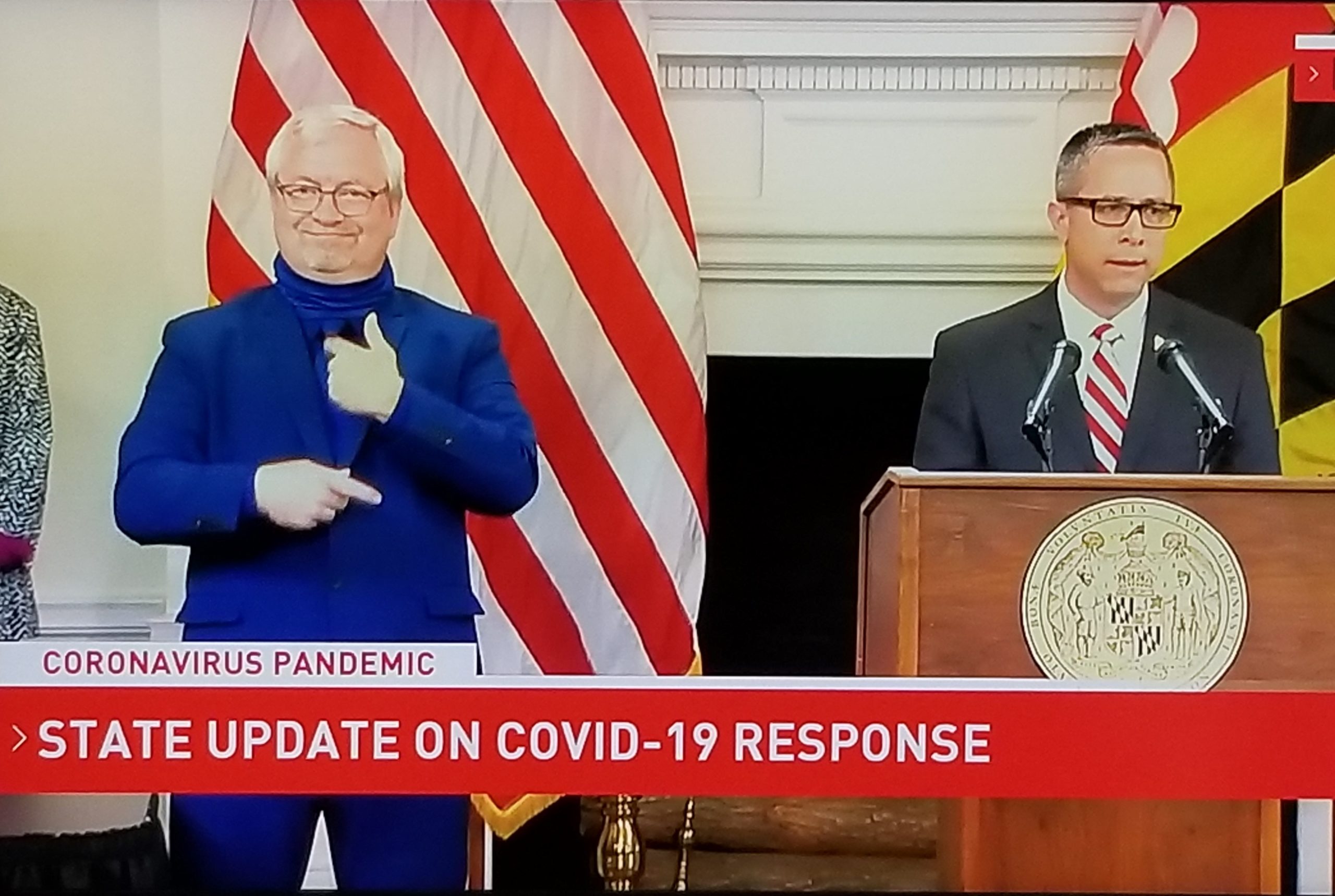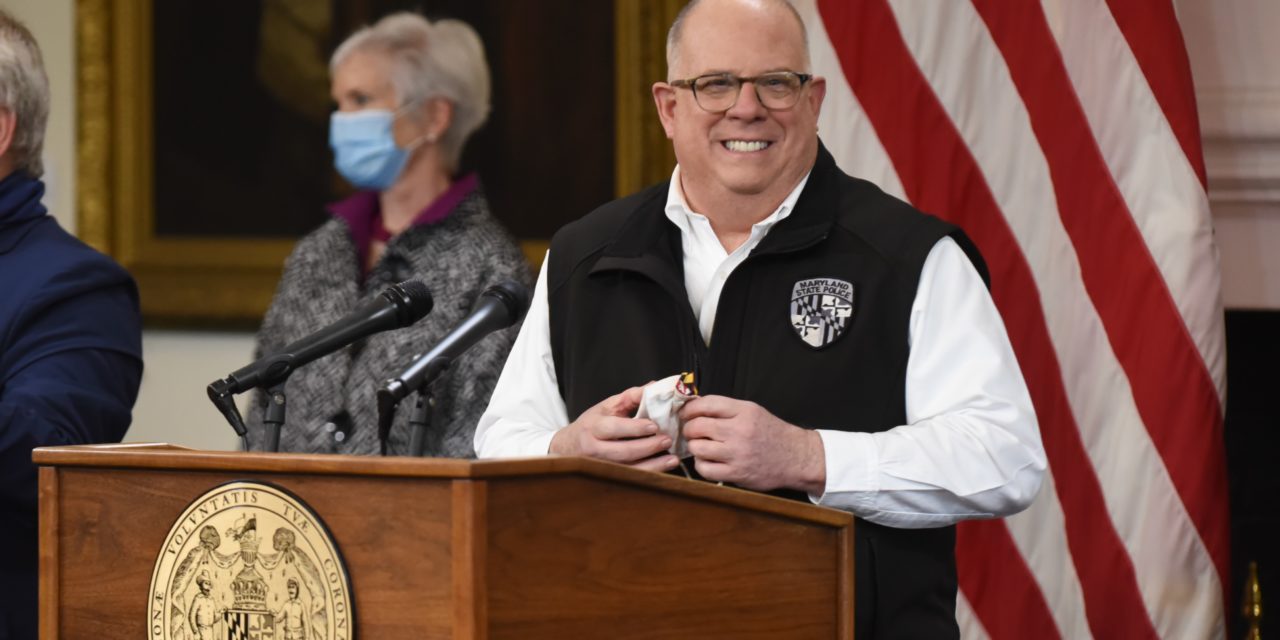Hogan green lights Maryland’s Parks, Beaches and Some Businesses to Open
Gov. Larry Hogan, shown at his news conference at the State House in Annapolis on Wednesday seemed optimistic about the state’s reopening plan, noting the progress that has been made. “Marylanders have made incredible sacrifices in recent weeks,” he said. (Office of the Executive Governor)
By Regina Holmes
Outdoor recreational activities such as golfing and boating that were banned in March due to the coronavirus pandemic can resume in Maryland on Thursday morning, when parks and beaches will open, Gov. Larry Hogan said Wednesday — signaling that the state is taking baby steps toward reopening.
In addition to golfing and recreational boating, camping, hunting, fishing, tennis and horseback riding will be allowed as of 7 a.m., Hogan said during an afternoon news conference at the State House in Annapolis.
Walking, jogging, swimming and fishing will be permitted on beaches, the governor said, but picnics, blankets and chairs still are banned there, according to an update concerning outdoor recreation that his office released after the news conference.
He stressed that Marylanders still must adhere to strict social distancing measures when participating in these outdoor activities, and he urged people to avoid large groups.
The governor also said people may now schedule elective surgeries, up to the discretion of their health provider. Patients and staff must be screened, however.
The easing of restrictions on outside recreational activities and elective surgeries are part of the first stage of the governor’s three-stage reopening plan for the state. The 30-page “Maryland Strong Roadmap to Recovery” plan, which he unveiled on April 24, classifies the three stages as low-risk, medium-risk and high-risk. Each stage has different categories within it. The changes he announced Wednesday are all in the low-risk stage.
Hogan said he was hoping that the state’s COVID-19 hospitalizations and ICU stays would plateau. He has said that he would weigh those metrics when determining how to implement the Roadmap.
“Fortunately, we are beginning to see those encouraging numbers,” he said. In the past seven days, those numbers dropped for five straight days although there was a slight bump on Tuesday, he said.
“If these trends continue into next week, we will be ready to begin to lift our stay-at-home order,” he said.
“Our recovery was built upon four essential building blocks which needed to be put in place before we could begin Stage One of our recovery: expanded testing, increased hospital surge capacity and supply of PPE [personal protective equipment], and a robust contact tracing operation.”
The governor then outlined the progress that has been made in each of the four building blocks.
Testing
“We have been able to expand our testing capacity to cover outbreaks, clusters and hotspots across the state,” he said.
- Completed a survey of all nursing homes and “trained special bridge teams to perform universal testing for all residents and staff.”
- Testing health-care workers and first responders at local fire and EMS departments as well as state workers at the departments of Health, Public Safety and Corrections, and Juvenile Services.
- Extending the days and hours of operation for testing at the eight Vehicle Emissions Inspection Program stations in the state where drive-thru COVID-19 testing is available by appointment only.
- Tested 2,300 people last weekend at Purdue Stadium in Salisbury, in response to outbreaks at poultry processing plants on the Eastern Shore.
- Conducting universal testing “shift by shift” at both of the state’s poultry processing plants “to ensure that every single poultry worker is tested.”
- Putting a surge tent at Easton Memorial Hospital to “prepare for an expected spike in patients” due to the poultry-plant outbreaks.
- Increased lab capability.
Surge capacity
- The state now has 8,100 hospital beds across the state for surge capacity, exceeding the goal of 6,000. The new total includes 2,400 intensive care unit beds.
- Laurel Medical Center, which officially reopened for COVID-19 patients on April 22, is adding a new wing and Adventist Hospital in Takoma Park is adding more rooms. Maryland’s highest concentration of COVID-19 cases are in Prince George’s County followed by Montgomery County, Hogan said.
Contact tracing
- A new contract with National Opinion Research will enable Maryland “to quadruple its disease investigation capability” up to 1,000 new cases per day. Hundreds of contact tracers are being hired, with more than 900 applicants in 20 of the state’s 24 jurisdictions.
- The Centers for Disease Control and Prevention “is on the ground in Salisbury to assist with contact tracing,” he said. The federal officials were summoned to address COVID-19 outbreaks among poultry workers. The state is continuing to coordinate with officials in Delaware and Virginia to protect the Delmarva region’s poultry industry and the nation’s food supply chain.
Personal protective equipment
“Our multi-agency task force has been working around the clock, seven days a week, focused on increasing our supply of desperately needed PPE — and they are making great progress,” Hogan said. The state received swabs for testing from the Federal Emergency Management Agency, he said, and other supplies are arriving in warehouses daily. The state recently secured the following:
- KN95 masks: 4.5 million
- N95 masks: 600,000
- Face shields: 1.1 million
- Surgical gloves: 3.5 million
- Gowns: 150,000
- Hand sanitizer: 47,000 gallons
- Infrared thermometers: 500,000
Hogan said Gilead Sciences Inc.(based in Foster City, Calif.) has donated 1,600 doses of Remdesivir, the only drug that has been proven in a clinical study to effectively treat COVID-19 patients. The initial doses are going to Prince George’s and Montgomery counties, “where we have the highest number of cases,” Hogan said.
This week the state launched the Maryland Manufacturing Network Supplier Portal, “an online platform that helps connect our Maryland suppliers with buyers who are looking to source PPE and other critical supplies,” the governor said.
He noted the challenges Maryland and other states have faced getting PPE.
“Due to the tremendous and urgent demand, and the serious lack of worldwide supply of PPE, states have had to go to extraordinary lengths to acquire this critical protective equipment on an emergency basis,” said Hogan, who is chair of the National Governors Association. “Unfortunately, across the county, there have been some cases of fraud.”
Last week, he said, he directed the Department of General Services to cancel an emergency PPE order for masks and ventilators at Blue Flame Medical due to the company’s “failure to perform and potential misrepresentation.”
Hogan said he told Maryland Attorney General Brian Frosh to investigate Blue Flame Medical for suspected fraud. The U.S. Department of Justice said on Wednesday that it is investigating the company’s contracts with multiple states, Hogan noted. California reportedly wired $500,000 million to the company for masks, he added.
“It is unconscionable that anyone would try to exploit this pandemic for profit or for personal gain, which is why I am so pleased that we are were able to act so swiftly to uncover Blue Flame’s potential wrongdoings and to alert the authorities,” Hogan said.
The governor said that on Tuesday the verv first patients in the United States were given a test vaccine at the University of Maryland School of Medicine as part of a global vaccine development program.
Dr. David Marcozzi of the University of Maryland Medical System, the Coronavirus Recovery Team’s COVID-19 incident commander, joined Hogan at the news conference and also urged Marylanders to resume scheduling elective surgeries. He also encouraged people to use telehealth to consult with providers for physical or mental health concerns.
Marcozzi reminded Marylanders to maintain physical distance, practice good hand hygiene and congregate in small groups both indoors and outdoors to protect those at high risk for COVID-19.
“To continue to flatten the curve, we Marylanders need to be consistently making the right choices, for ourselves and our friends and our family,” Marcozzi said. This is the time to take care of ourselves, both physically and mentally. Let’s make sure we do both.”


MarylandReporter.com is a daily news website produced by journalists committed to making state government as open, transparent, accountable and responsive as possible – in deed, not just in promise. We believe the people who pay for this government are entitled to have their money spent in an efficient and effective way, and that they are entitled to keep as much of their hard-earned dollars as they possibly can.

